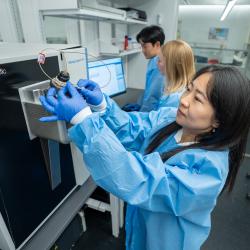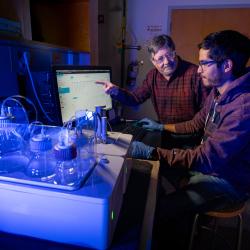Study Explains Ancient Animal Fossilization
The mountains of the Ningqiang area, in the southern Shaanxi province of south China, are a paleontological gold mine, according to an international research team that included University of Maryland geologist Alan Kaufman.
Researchers collected a variety of samples from a specific locality in this region—known as the Gaojiashan Lagerstätte, a German term for a uniquely preserved fossil accumulation—to aid in their ongoing paleobiology and taphonomy research. While they didn’t find actual gold, they did find incredible fossils with a gold-like luster from pyrite—more commonly known as “fool’s gold”—and an invaluable story to tell scientists about the preservation of some of the earth’s first animals.
The fossils are more than 540 million years old, from the latest Ediacaran Period. The skeletal structure of a tube is evident in the fossils, but scholars have been left to speculate about the soft-bodied, worm-like creature that once lived inside of these tubes. The mode of preservation of these fossils is quite similar to those of many famous Cambrian-aged localities, such as the ~505 million year-old Burgess Shale, where the animals are preserved as thin films of organic matter on rock surfaces. There has been ongoing debate about this style of preservation, and a study published online Dec. 17, 2014 in the journal Nature Communications proposes a new hypothesis.
“This remarkably detailed study provides new insights into how organisms lacking hard parts, like bones and teeth, can be preserved through time,” says Kaufman, a study co-author who helped evaluate the data. “This is especially true for the time when animals first appeared on Earth, so understanding the factors involved in their preservation sheds light on the environments in which they lived and ultimately diversified into modern animal phyla.”
The research team took a careful look at the fossils using a variety of chemical analyses. They found that the pyrites on the outside of the tube have different chemical signatures than those on the inside the tube.
“This means that the outside of the tube was pyritized first, and the pyrite grew inward,” says the study’s lead author James Schiffbauer, assistant professor of geology at the University of Missouri. “This allows us to describe a mechanism for, and put a timeline on, the sequence of events that led to the fossilization of these animals.”
The pyritization process was fueled by microscopic bacteria known as sulfate reducers, which were responsible for decay of the worm’s soft tissue, and are an important community of microbes that cycle carbon in present-day oceans.
“In this case, the destructive process and the constructive process are exactly the same,” says Schiffbauer. “The sulfate reducers that destroyed the tissue are also responsible for preserving the fossil.”
The researchers estimate that this process happened quickly, between 10 and 800 years. If the decaying animal was buried quicker, the resulting fossil would instead be like the thin carbon films found on rock surfaces of the Burgess Shale, rather than three-dimensionally pyritized as mostly seen in the Gaojiashan. By describing the preservation process and also putting constraints on the timing, the study sheds new light on the relationship between decay and fossilization.
“The proposed processes may shed light on the lifestyles of the most ancient animals, and of the chemistry of the oceans where they thrived,” says Kaufman. “We will undoubtedly apply these techniques and others to our studies of the origin and diversification of life."
In addition to Kaufman and Shiffbauer, study authors included Shuhai Xiao and Jerry Hunter of Virginia Tech; Yaoping Cai and Hong Hua of Northwest University, Xi’an, China; Adam Wallace of the University of Delaware; Huifang Xu of the University of Wisconsin; and Yongbo Peng of Indiana University.
This research was supported by the NASA Exobiology and Evolutionary Biology Program, NASA Astrobiology Institute (Award No. N07-5489); National Science Foundation (Award Nos. EAR-0824890, EAR-095800, EAR-1124062, EAR-1338810 and CHE-1305892); Chinese Academy of Sciences; National Natural Science Foundation of China (Award Nos. 41202006, 41030209 and 41272011); and Chinese Ministry of Science and Technology. The content of this article does not necessarily reflect the views of these organizations.
The research paper, “A unifying model for Neoproterozoic–Palaeozoic exceptional fossil preservation through pyritization and carbonaceous compression,” James D. Schiffbauer, Shuhai Xiao, Yaoping Cai, Adam F. Wallace, Hong Hua, Jerry Hunter, Huifang Xu, Yongbo Peng and Alan J. Kaufman, was published Dec. 17, 2014 in Nature Communications.
Media Relations Contacts: University of Maryland/Abby Robinson, 301-405-5845, abbyr@umd.edu; University of Missouri/Kristi Galloway, gallowayke@missouri.edu, 573-884-2197
Writer: University of Missouri/Kristi Galloway
University of Maryland
College of Computer, Mathematical, and Natural Sciences
2300 Symons Hall
College Park, MD 20742
www.cmns.umd.edu
@UMDscience
About the College of Computer, Mathematical, and Natural Sciences
The College of Computer, Mathematical, and Natural Sciences at the University of Maryland educates more than 7,000 future scientific leaders in its undergraduate and graduate programs each year. The college's 10 departments and more than a dozen interdisciplinary research centers foster scientific discovery with annual sponsored research funding exceeding $150 million.







